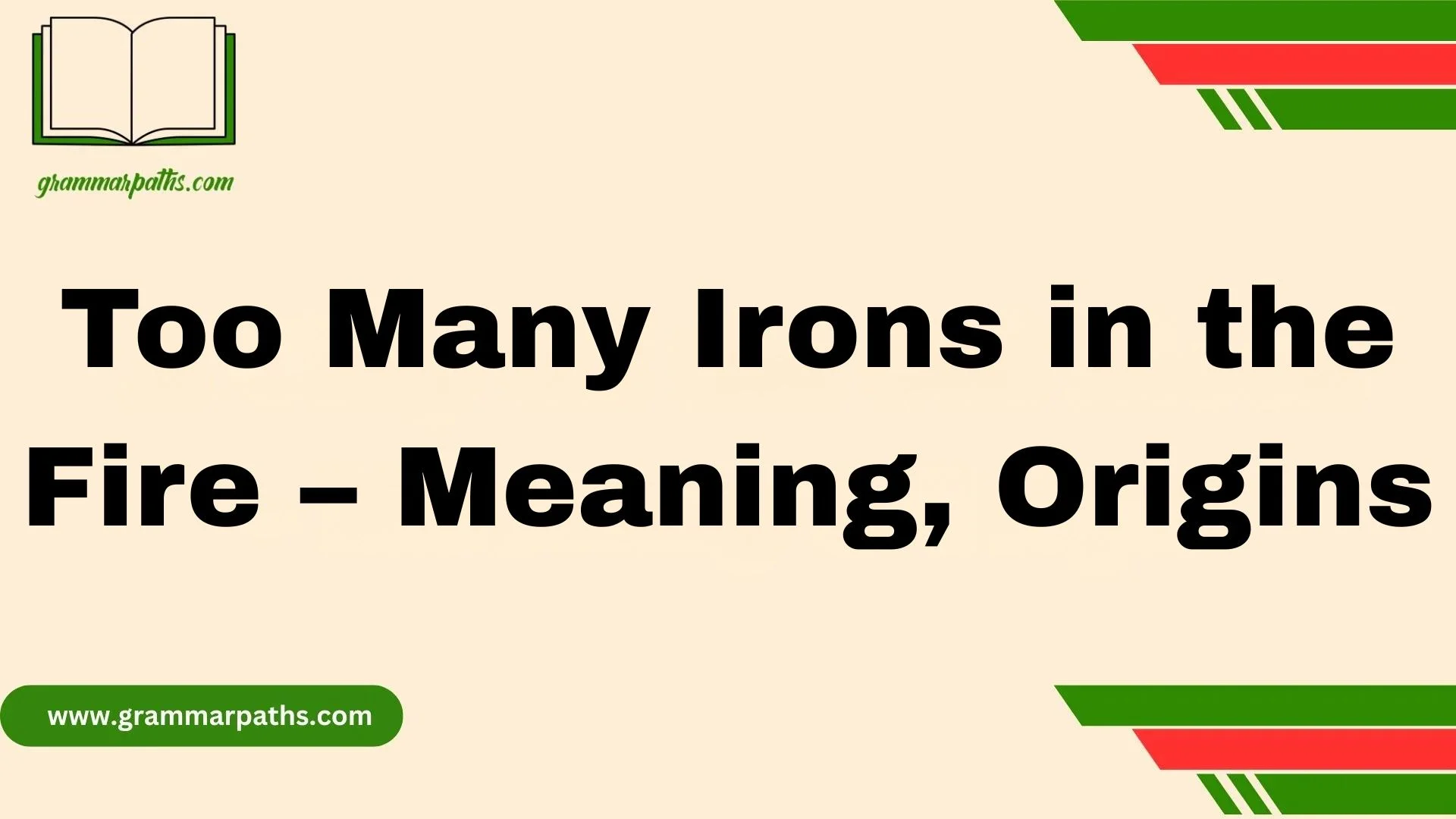I’ve often seen people try to handle too many tasks at once, like keeping irons in a forge without giving each enough attention. The phrase Too Many Irons in the Fire – Meaning, Origins comes from historical context in smithing, where a craftsman with overextended projects risked mistakes and failure. This old idiom acts as a cautionary proverb, warning about overwhelming commitments and the strain they place on productivity, efficiency, and quality. From my own experience, juggling priorities without proper planning and organization quickly leads to stress, pressure, and burnout—a lesson in time management that’s as relevant now as it was in the 18th century.
Whenever I feel scattered or unfocused, I remind myself of the wisdom in this proverb—finish what you start before adding new responsibilities. Success often requires balance, moderation, and wise choices in setting realistic goals. Trying to maintain too many projects can divide attention, overload capacity, and harm results. Careful allocation of time and resources, alongside discipline, helps avoid being overextended while still delivering strong performance. In both trade and modern life, the ability to handle work within your skill and patience is what turns potential chaos into lasting achievement.
What Does “Too Many Irons in the Fire” Mean?
At its core, “too many irons in the fire” means taking on more tasks or responsibilities than you can handle effectively. It suggests that overcommitting leads to inefficiency, mistakes, or burnout.
Everyday American examples:
- A small business owner launching three new product lines at once.
- A college student signing up for five extracurricular clubs on top of full-time classes.
- A parent working a full-time job, running a side business, and volunteering for three organizations.
In all these cases, the problem isn’t ambition—it’s spreading yourself too thin.
Quick takeaway: More irons can mean more opportunities, but too many can ruin them all.
The Origin of the Phrase
The phrase comes from blacksmithing, a trade that’s been around for thousands of years. In the literal sense, an “iron in the fire” refers to a piece of metal heating in a forge, ready to be shaped.
Why too many irons were a problem:
- Overheating: If left in too long, iron could burn or become brittle.
- Distraction: Managing several pieces at once increased the chance of mistakes.
- Timing: Each iron needed precise attention at the right moment.
The idiom first appeared in print in the late 16th century in England. By the 17th and 18th centuries, it was commonly used in the American colonies. Early settlers, many of whom worked as blacksmiths or farmers, instantly understood the metaphor.
Historical Context and Evolution
Blacksmithing was a cornerstone trade in early America. Every town had at least one blacksmith—responsible for making tools, horseshoes, and hardware. In that environment, the idiom was both literal and metaphorical.
Key moments in the idiom’s evolution:
| Time Period | Development |
| 1500s (England) | First recorded usage in literary works. |
| 1600s | Spread through colonial America as settlers brought the phrase with them. |
| 1800s | Appeared in newspapers, advice columns, and personal letters in a figurative sense. |
| 1900s | Became a staple in business and self-help literature. |
By the late 1800s, the phrase had fully transitioned from a trade-specific term to a general caution against overcommitment.
From Forge to Modern Speech
The industrial revolution in the US replaced many small-town blacksmith shops with mass production, but the phrase survived. Instead of irons in a fire, Americans now had projects on their desk or emails in their inbox.
Examples of 20th-century usage:
- 1920s newspapers warning business owners against diversifying too quickly.
- WWII-era advice columns telling homemakers not to “put too many irons in the fire” during rationing.
- 1970s management books using it as shorthand for ineffective multitasking.
By the 21st century, the idiom had become common in American workplace jargon, often linked to project management and productivity.
The “Too Many Irons in the Fire” Problem in Modern America
Today, the phrase is more relevant than ever. The US has a multitasking culture fueled by digital technology, side hustles, and a constant pressure to “do more.”
Relevant facts:
- According to the American Institute of Stress, 83% of US workers suffer from work-related stress, much of it from juggling too many tasks.
- The Pew Research Center reports that 28% of Americans have a side job in addition to their main employment.
- A Gallup study found that only 2.5% of people can multitask effectively—yet most Americans believe they can.
Common modern scenarios:
- Corporate managers leading five projects at once.
- Parents acting as full-time caregivers, workers, and volunteers.
- Students balancing internships, athletics, and part-time jobs.
Psychological and Productivity Insights
Science backs up the warning in this old idiom. Cognitive load theory explains that our brains have limited working memory. When overloaded, performance drops sharply.
Research findings:
- A Stanford University study found that heavy multitaskers perform worse on memory and focus tests than those who single-task.
- The American Psychological Association notes that switching between tasks can cost up to 40% of productive time.
Signs you may have too many irons in the fire:
- Constantly missing deadlines.
- Feeling mentally scattered or exhausted.
- Producing lower-quality work.
- Procrastinating because you don’t know where to start.
Productivity expert David Allen once said: “You can do anything, but not everything.” This is the heart of the idiom’s wisdom.
Real-Life Examples and Anecdotes
Case Study 1 – The Overloaded Entrepreneur
John, a New York tech founder, tried launching three apps at once. Instead of three successes, he ended up with three incomplete products, frustrated investors, and burned-out employees. Lesson: Focus beats ambition without boundaries.
Case Study 2 – The Supermom Syndrome
Lisa, a Chicago mother of three, took on a full-time job, PTA presidency, and a community garden project. Six months in, she was exhausted, stressed, and disengaged from her family. She eventually dropped two commitments and regained her health.
Case Study 3 – The Student Juggler
Alex, a Boston University student, joined five clubs while taking a heavy course load. His GPA dropped, and he realized he was doing everything halfway. By cutting back to two clubs, he improved his grades and enjoyed his activities more.
The Idiom in American Media and Pop Culture
The phrase pops up in TV, music, books, and speeches.
Examples:
- TV: Used in shows like The Office to describe characters taking on too many work assignments.
- Music: Country songs often reference the idiom when describing busy, overworked lives.
- Literature: Appears in self-help books like Stephen Covey’s The 7 Habits of Highly Effective People when discussing focus.
Pop culture reinforces the idea that spreading yourself too thin rarely leads to success.
Applying the Idiom to Business and Work-Life Balance
In business, “too many irons in the fire” is a strategic risk. Companies that pursue too many initiatives at once often suffer loss of focus and profitability.
Strategies to avoid overcommitment:
- Prioritize – Focus on high-impact tasks.
- Delegate – Share responsibility where possible.
- Set boundaries – Say no to low-priority opportunities.
- Schedule downtime – Prevent burnout.
Work-life balance tips:
- Use the 80/20 rule: Focus on the 20% of tasks that deliver 80% of results.
- Limit major commitments to three at a time.
- Review your “irons” monthly and remove any that don’t serve your goals.
Common Variations and Similar Expressions
Americans use several phrases similar in meaning to “too many irons in the fire”:
| Idiom | Meaning | Usage Context |
| Biting off more than you can chew | Taking on a task too big to handle | Personal and professional |
| Burning the candle at both ends | Overworking, often to exhaustion | Work-life balance |
| Jack of all trades, master of none | Doing many things but excelling at none | Skills and careers |
While the imagery differs, the message is the same: focus beats overextension.
Conclusion
The story of Scrooge has become more than just a fictional character from Charles Dickens’s novel A Christmas Carol—it is now a universal and cultural reference for stinginess, coldness, and a lack of festive spirit. Over the years, the term has transformed into a label for someone who refuses to split the bill, avoids giving a gift, or even quietly dismisses the joy of the holidays. From its literary origins in December to its powerful symbolic meaning in everyday language, “Scrooge” remains a word that we’ve all heard more than once, especially in contexts where a person might be seen as cheap. I’ve always found it fascinating how one story could be turned into such a colorful, richness-filled expression that people still toss around today without even thinking of where it actually comes from.
Whether used in name-calling for fun, in sayings or idioms, or as a pejorative slang, “Scrooge” has become a timeless example of how popular culture, dramatic influences, and everyday scenarios can give life to a word that sticks. Its transformation from a character into a powerful metaphor shows the richness of language and how meanings evolve. The story not only offers a reminder of generosity but also demonstrates how words, when tied to memorable characters and unique attributes, can become essential for describing certain behaviors and mannerisms in a way that feels relatable to many.
FAQs
Q1: What does the term “Scrooge” mean today?
A “Scrooge” refers to a person who is ungenerous, avoids spending money, and lacks festive or giving spirit, especially during the holidays.
Q2: Where does the term “Scrooge” come from?
It originates from Ebenezer Scrooge, the main antagonist in Charles Dickens’s 1843 novel A Christmas Carol.
Q3: Why is “Scrooge” still used in modern language?
Because it’s a powerful cultural reference that instantly communicates stinginess or lack of warmth, making it easy for people to relate to.
Q4: Can “Scrooge” ever be used in a positive sense?
Rarely—it’s usually negative, but in some cases, it can be playfully used among friends without offense.
Q5: Is “Scrooge” only relevant during December or the holidays?
No, it can be used year-round to describe anyone who is seen as cheap or unwilling to share, regardless of the season.

Grace Marie is the dedicated writer behind GrammarPaths.com, where she shares her passion for English grammar, idioms, and writing mastery. With a strong background in language studies and years of experience helping learners improve their communication skills, Grace creates clear, practical, and engaging content that makes English easy to understand.










